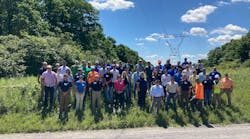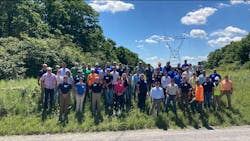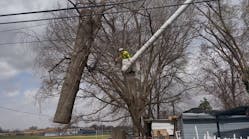4 Takeaways from the 2022 ROW Sustainability Summit
Utility companies throughout the United States are responsible for managing approximately 6 million miles of transmission and distribution lines, which weave across the country. This is a significant undertaking, as practices used to manage utility rights-of-way (ROW) can significantly impact environmental sustainability, wildlife habitat, public perception and the cost-efficiency of vegetation management programs.
Nearly 60 electric operators, vegetation managers, vendors and members of nongovernmental organizations recently attended the 2022 ROW Sustainability Summit from June 28-30 in State College, Pennsylvania, to discuss and analyze these implications. Presented by FirstEnergy, the Utility Arborist Association, Corteva Agriscience, Pennsylvania State University, Rights-of-Way as Habitat Working Group and the University of Illinois-Chicago (UIC), the event is structured to keep key decision-makers and other influencing parties from the utility industry up to date on the latest trends impacting the energy sector.
To supplement this informative event, attendees were given a firsthand look at the State Game Lands 33 research site, which showcases nearly 70 years of research concerning the environmental impact of various vegetation control strategies commonly used throughout utility ROW. Educational presentations and expert panels also provided impactful opportunities for attendees to learn about resources and strategies that can help improve not only grid reliability, but also environmental sustainability, cost efficiency and communication with a variety of internal and external contacts.
ROW Sustainability Summit attendees following their field tour of the State Game Lands 33 research site.
The summit culminated with breakout sessions in which attendees discussed key challenges and opportunities identified over the course of the three-day event. Primary takeaways from those sessions include the following:
1. Budget and workforce resources are still formidable obstacles
Several presentations cited Integrated Vegetation Management (IVM) strategies, including chemical and mechanical control methods, as best management practices for practitioners working to control incompatible vegetation throughout utility ROW. Results achieved through SGL 33 research has showcased the manner in which IVM programs can support the development of biodiverse wildlife habitat, and cost analysis studies have supported the use of IVM-based strategies as a means to reduce long-term maintenance costs. Despite these benefits, many vegetation managers continue to reference budget limitations as an impediment to programmatic change.
Information shared with summit attendees acknowledged that applying herbicides as part of an IVM program will require additional costs upon inception. However, industry research shows that the cost of mechanical maintenance will likely overtake the cost of IVM-based practices by the following maintenance cycle. As herbicide applications can effectively reduce long-term maintenance requirements, vegetation managers can expect to do more with less over time, which allows practitioners to reduce skilled workforce requirements, reallocate funding to priority sites and avoid a cyclical reclamation model.
2. What’s good for the environment is good for business
The SGL 33 field tour and summit presentations featuring researchers, working group members and vegetation management specialists detailed the ways in which utility companies can reduce their environmental footprint to enhance biodiverse habitat development. Attendees also learned about the negative impact mowing practices can have on carbon emissions as well as habitat scorecards, assessment practices and treatment strategies that can help organizations document their commitment to environmental sustainability.
Supplemental insights described the ways in which IVM practices can help practitioners reduce carbon emissions and safeguard wildlife habitat while achieving their goals of enhancing electrical service reliability. In turn, these results allow utility companies to publicly showcase their commitment to sustainability through Environmental, Social and Governance (ESG) reporting, which often improves public perception and proactively offsets unforeseen industry headwinds.
3. Change management is a progressive evolution
Throughout the summit, attendees were reminded that IVM is not an overnight solution. While it will take time for programs to implement best practices and reap the benefits of an IVM-based approach, the overarching message was that investing in sustainable solutions now will position programs for progressive growth that can lead to sustainable success in the near and distant future.
4. Internal and external communication is key
Above all, the 2022 ROW Sustainability Summit revealed an overwhelming call to action for utility companies and their vegetation management counterparts: communicate, engage and collaborate. Communicating the benefits of IVM-based strategies can help utility companies inform the general public. This can lead to engaging conversations that improve share of voice for landowners and other land entities.
However, vegetation managers can’t do it alone. That’s why it’s important for utility companies and their contract partners to collaborate with like-minded working groups and other industry entities that can help establish best management practices, showcase commitments to sustainability, and adapt best management practices that enhance results, reduce scrutiny and increase public understanding of the intended results for each applied strategy.
Industry professionals are encouraged to learn more about the 2022 ROW Sustainability Summit by visiting the event page produced by UIC. Otherwise, additional information on SGL 33 research and the positive impact IVM programs can have on environmental sustainability throughout utility ROW can be found at HabitatWithHerbicides.com.
™ ® Trademarks of Corteva Agriscience and its affiliated companies. © 2022 Corteva.
Sponsored By:




